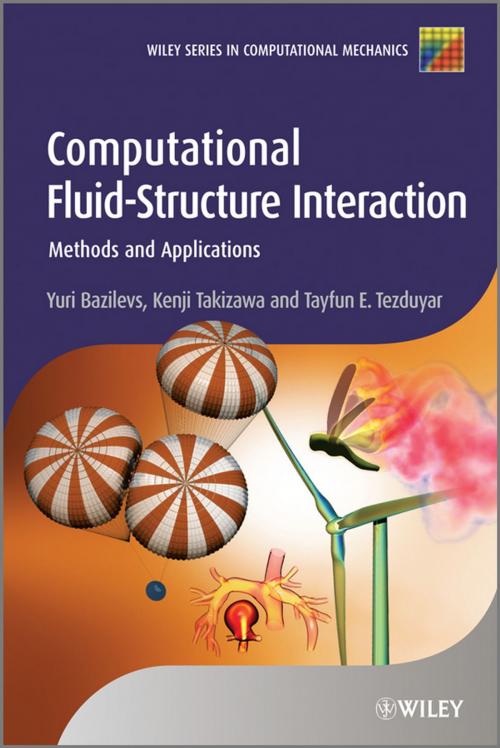Computational Fluid-Structure Interaction
Methods and Applications
Nonfiction, Science & Nature, Technology, Drafting & Mechanical Drawing| Author: | Kenji Takizawa, Tayfun E. Tezduyar, Yuri Bazilevs | ISBN: | 9781118483572 |
| Publisher: | Wiley | Publication: | January 25, 2013 |
| Imprint: | Wiley | Language: | English |
| Author: | Kenji Takizawa, Tayfun E. Tezduyar, Yuri Bazilevs |
| ISBN: | 9781118483572 |
| Publisher: | Wiley |
| Publication: | January 25, 2013 |
| Imprint: | Wiley |
| Language: | English |
Computational Fluid-Structure Interaction: Methods and Applications takes the reader from the fundamentals of computational fluid and solid mechanics to the state-of-the-art in computational FSI methods, special FSI techniques, and solution of real-world problems. Leading experts in the field present the material using a unique approach that combines advanced methods, special techniques, and challenging applications.
This book begins with the differential equations governing the fluid and solid mechanics, coupling conditions at the fluid–solid interface, and the basics of the finite element method. It continues with the ALE and space–time FSI methods, spatial discretization and time integration strategies for the coupled FSI equations, solution techniques for the fully-discretized coupled equations, and advanced FSI and space–time methods. It ends with special FSI techniques targeting cardiovascular FSI, parachute FSI, and wind-turbine aerodynamics and FSI.
Key features:
- First book to address the state-of-the-art in computational FSI
- Combines the fundamentals of computational fluid and solid mechanics, the state-of-the-art in FSI methods, and special FSI techniques targeting challenging classes of real-world problems
- Covers modern computational mechanics techniques, including stabilized, variational multiscale, and space–time methods, isogeometric analysis, and advanced FSI coupling methods
- Is in full color, with diagrams illustrating the fundamental concepts and advanced methods and with insightful visualization illustrating the complexities of the problems that can be solved with the FSI methods covered in the book.
- Authors are award winning, leading global experts in computational FSI, who are known for solving some of the most challenging FSI problems
Computational Fluid-Structure Interaction: Methods and Applications is a comprehensive reference for researchers and practicing engineers who would like to advance their existing knowledge on these subjects. It is also an ideal text for graduate and senior-level undergraduate courses in computational fluid mechanics and computational FSI.
Computational Fluid-Structure Interaction: Methods and Applications takes the reader from the fundamentals of computational fluid and solid mechanics to the state-of-the-art in computational FSI methods, special FSI techniques, and solution of real-world problems. Leading experts in the field present the material using a unique approach that combines advanced methods, special techniques, and challenging applications.
This book begins with the differential equations governing the fluid and solid mechanics, coupling conditions at the fluid–solid interface, and the basics of the finite element method. It continues with the ALE and space–time FSI methods, spatial discretization and time integration strategies for the coupled FSI equations, solution techniques for the fully-discretized coupled equations, and advanced FSI and space–time methods. It ends with special FSI techniques targeting cardiovascular FSI, parachute FSI, and wind-turbine aerodynamics and FSI.
Key features:
- First book to address the state-of-the-art in computational FSI
- Combines the fundamentals of computational fluid and solid mechanics, the state-of-the-art in FSI methods, and special FSI techniques targeting challenging classes of real-world problems
- Covers modern computational mechanics techniques, including stabilized, variational multiscale, and space–time methods, isogeometric analysis, and advanced FSI coupling methods
- Is in full color, with diagrams illustrating the fundamental concepts and advanced methods and with insightful visualization illustrating the complexities of the problems that can be solved with the FSI methods covered in the book.
- Authors are award winning, leading global experts in computational FSI, who are known for solving some of the most challenging FSI problems
Computational Fluid-Structure Interaction: Methods and Applications is a comprehensive reference for researchers and practicing engineers who would like to advance their existing knowledge on these subjects. It is also an ideal text for graduate and senior-level undergraduate courses in computational fluid mechanics and computational FSI.















